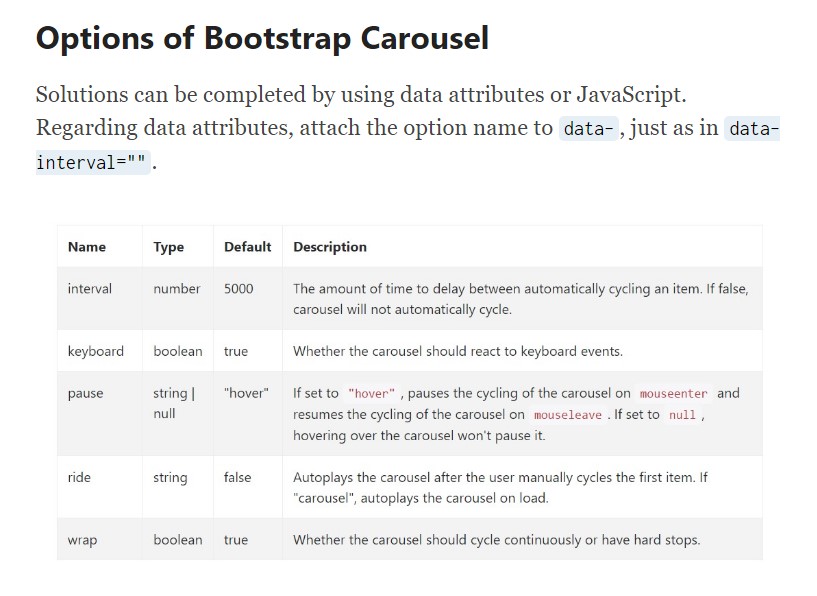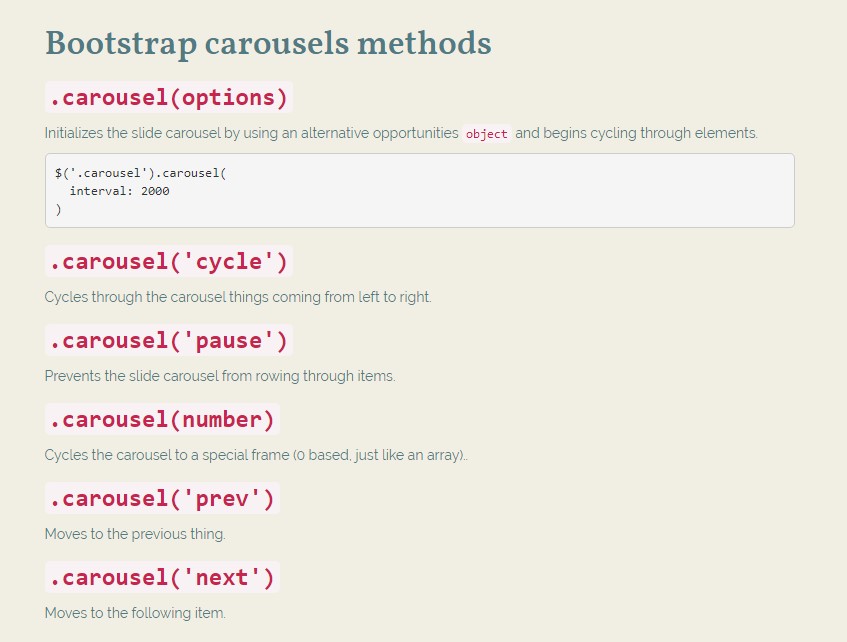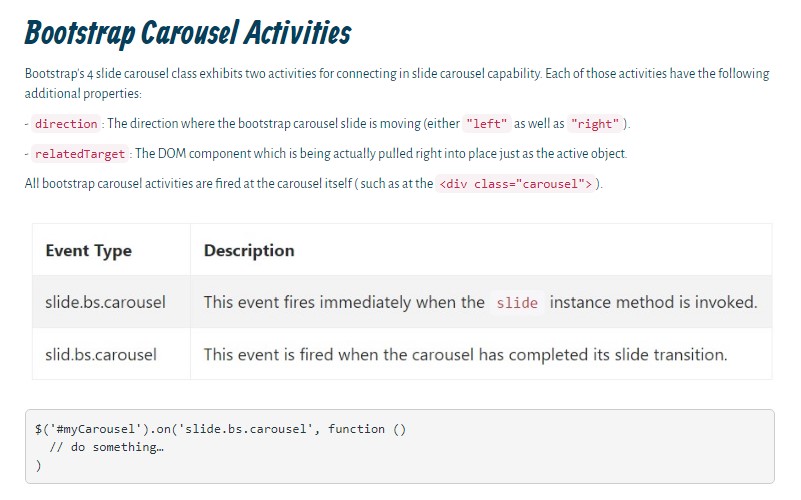Bootstrap Carousel Position
Intro
Who exactly doesn't like shifting photos plus amazing interesting captions and text message describing what exactly they show, more effective delivering the information or even why not actually even preferable-- as well featuring a number of switches near asking the site visitor to take some activity at the very beginning of the webpage due to the fact that these are usually applied in the start. This has been really dealt with in the Bootstrap framework with the installed carousel feature that is totally supported and pretty easy to get as well as a clean and plain building.
The Bootstrap Carousel Responsive is a slide show for cycling across a series of content, developed with CSS 3D transforms and a piece of JavaScript. It collaborates with a series of pictures, message, or else custom-made markup. It as well features support for previous/next regulations and hints.
The best way to work with the Bootstrap Carousel Mobile:
All you require is a wrapper feature with an ID to provide the whole carousel component coming with the
.carousel.slidedata-ride="carousel"carousel-inner.carousel-innerSome example
Slide carousels really don't instantly stabilize slide proportions. Because of this, you might need to apply special utilities or custom made designs to accurately shape content. While carousels support previous/next directions and indications, they are certainly not explicitly needed. Customize and add considering that you see fit.
Make sure to put a unique id on the
.carouselOnly slides
Here is a Bootstrap Carousel Slide along with slides solely . Note the presence of the
.d-block.img-fluid<div id="carouselExampleSlidesOnly" class="carousel slide" data-ride="carousel">
<div class="carousel-inner" role="listbox">
<div class="carousel-item active">
<div class="img"><img class="d-block img-fluid" src="..." alt="First slide"></div>
</div>
<div class="carousel-item">
<div class="img"><img class="d-block img-fluid" src="..." alt="Second slide"></div>
</div>
<div class="carousel-item">
<div class="img"><img class="d-block img-fluid" src="..." alt="Third slide"></div>
</div>
</div>
</div>What's more?
You may also set up the time each slide gets shown on webpage via putting in a
data-interval=" ~ number in milliseconds ~". carouselSlideshow together with controls
The site navigation between the slides gets performed through defining two url elements using the class
.carousel-control.left.rightrole=" button"data-slide="prev"nextThis so far refers to make sure the regulations will do the job the right way but to also assure the website visitor realizes these are there and knows what exactly they are doing. It additionally is a good idea to apply certain
<span>.icon-prev.icon-next.sr-onlyNow for the necessary aspect-- positioning the concrete pictures that ought to materialize inside the slider. Each image feature ought to be wrapped inside a
.carousel-item.item classIncorporating in the previous and next commands:

<div id="carouselExampleControls" class="carousel slide" data-ride="carousel">
<div class="carousel-inner" role="listbox">
<div class="carousel-item active">
<div class="img"><img class="d-block img-fluid" src="..." alt="First slide"></div>
</div>
<div class="carousel-item">
<div class="img"><img class="d-block img-fluid" src="..." alt="Second slide"></div>
</div>
<div class="carousel-item">
<div class="img"><img class="d-block img-fluid" src="..." alt="Third slide"></div>
</div>
</div>
<a class="carousel-control-prev" href="#carouselExampleControls" role="button" data-slide="prev">
<span class="carousel-control-prev-icon" aria-hidden="true"></span>
<span class="sr-only">Previous</span>
</a>
<a class="carousel-control-next" href="#carouselExampleControls" role="button" data-slide="next">
<span class="carousel-control-next-icon" aria-hidden="true"></span>
<span class="sr-only">Next</span>
</a>
</div>Employing indicators
You can easily also incorporate the indications to the carousel, alongside the controls, too
Inside the major
.carousel.carousel-indicatorsdata-target="#YourCarousel-ID" data-slide-to=" ~ appropriate slide number ~"
<div id="carouselExampleIndicators" class="carousel slide" data-ride="carousel">
<ol class="carousel-indicators">
<li data-target="#carouselExampleIndicators" data-slide-to="0" class="active"></li>
<li data-target="#carouselExampleIndicators" data-slide-to="1"></li>
<li data-target="#carouselExampleIndicators" data-slide-to="2"></li>
</ol>
<div class="carousel-inner" role="listbox">
<div class="carousel-item active">
<div class="img"><img class="d-block img-fluid" src="..." alt="First slide"></div>
</div>
<div class="carousel-item">
<div class="img"><img class="d-block img-fluid" src="..." alt="Second slide"></div>
</div>
<div class="carousel-item">
<div class="img"><img class="d-block img-fluid" src="..." alt="Third slide"></div>
</div>
</div>
<a class="carousel-control-prev" href="#carouselExampleIndicators" role="button" data-slide="prev">
<span class="carousel-control-prev-icon" aria-hidden="true"></span>
<span class="sr-only">Previous</span>
</a>
<a class="carousel-control-next" href="#carouselExampleIndicators" role="button" data-slide="next">
<span class="carousel-control-next-icon" aria-hidden="true"></span>
<span class="sr-only">Next</span>
</a>
</div>Provide a number of captions as well.
Add titles to your slides simply using the .carousel-caption feature just within any .carousel-item.
If you want to provide some underlines, definition as well as tabs to the slide add an additional
.carousel-captionThey are able to be efficiently hidden on compact viewports, as demonstrated here, utilizing alternative display screen functions. We conceal all of them at the beginning through
.d-none.d-md-block
<div class="carousel-item">
<div class="img"><img src="..." alt="..."></div>
<div class="carousel-caption d-none d-md-block">
<h3>...</h3>
<p>...</p>
</div>
</div>A bit more secrets
A cool secret is when you really want a link or perhaps a button upon your page to guide to the carousel but additionally a certain slide inside it being viewable at the moment. You are able to actually accomplish this simply by specifying
onclick=" $(' #YourCarousel-ID'). carousel( ~ the needed slide number );"Treatment
By data attributes
Make use of data attributes to effectively handle the placement of the slide carousel
.data-slideprevnextdata-slide-todata-slide-to="2"The
data-ride="carousel"By JavaScript
Employ carousel personally having:
$('.carousel').carousel()Options
Options may be completed by using data attributes or JavaScript. For data attributes, attach the option name to
data-data-interval=""
Practices
.carousel(options)
.carousel(options)Initializes the carousel having an extra options
object$('.carousel').carousel(
interval: 2000
).carousel('cycle')
.carousel('cycle')Cycles through the slide carousel elements from left to right.
.carousel('pause')
.carousel('pause')Prevents the carousel from cycling through things.
.carousel(number)
.carousel(number)Moves the slide carousel to a specific frame (0 based, just like an array)..
.carousel('prev')
.carousel('prev')Moves to the prior item.
.carousel('next')
.carousel('next')Moves to the next item.
Activities
Bootstrap's carousel class exposes two events for hooking in carousel useful functionality. Both activities have the following supplemental properties:
direction"left""right"relatedTargetEvery one of carousel activities are set off at the slide carousel in itself such as at the
<div class="carousel">
$('#myCarousel').on('slide.bs.carousel', function ()
// do something…
)Final thoughts
And so primarily this is the method the slide carousel feature is structured in the Bootstrap 4 framework. It is certainly really elementary and uncomplicated . Still it is very an user-friendly and attractive technique of presenting a lot of web content in much less area the carousel element should however be worked with very carefully considering the readability of { the message and the visitor's convenience.
Excessive pictures might be missed to get noticed by scrolling down the page and when they slide way too fast it might come to be challenging certainly spotting them as well as review the messages that might just sooner or later confuse or possibly annoy the webpage visitors or maybe an critical call to behaviour might be missed-- we certainly don't want this to materialize.
Inspect a few on-line video training regarding Bootstrap Carousel:
Related topics:
Bootstrap Carousel authoritative documents

Mobirise Bootstrap Carousel & Slider

Bootstrap 4 Сarousel issue

Responsive Bootstrap Carousel Slider
CSS Bootstrap Image Carousel with Autoplay
CSS Bootstrap Image Carousel Slideshow





